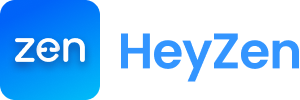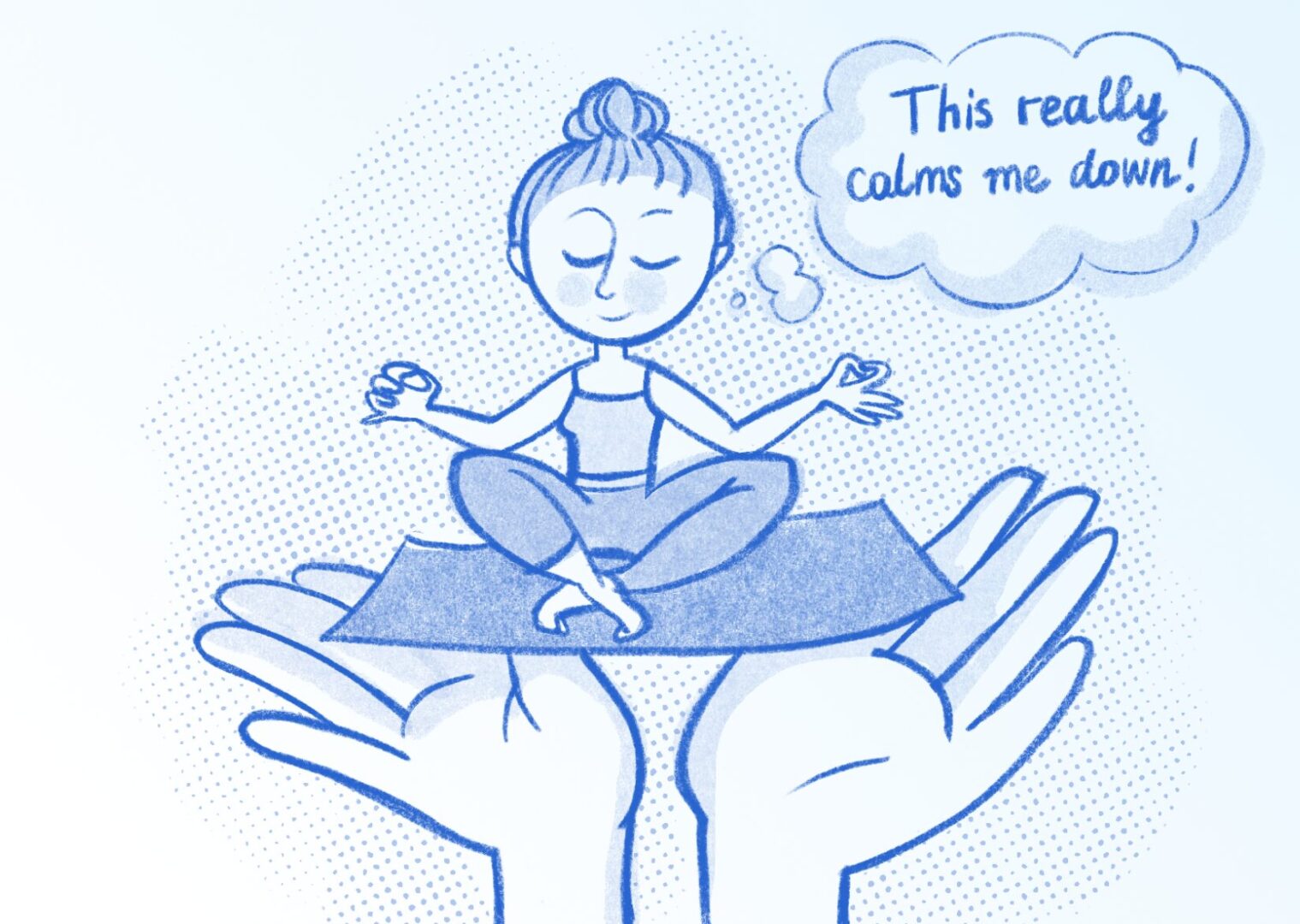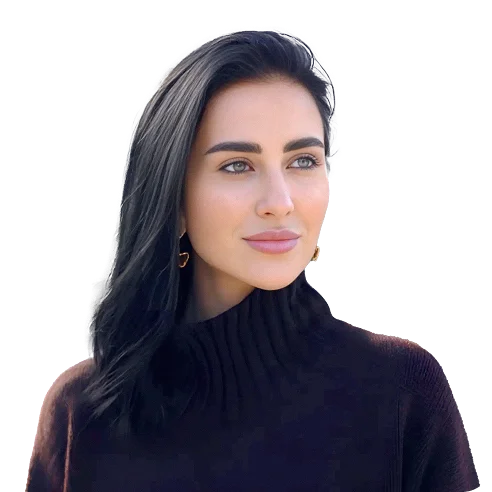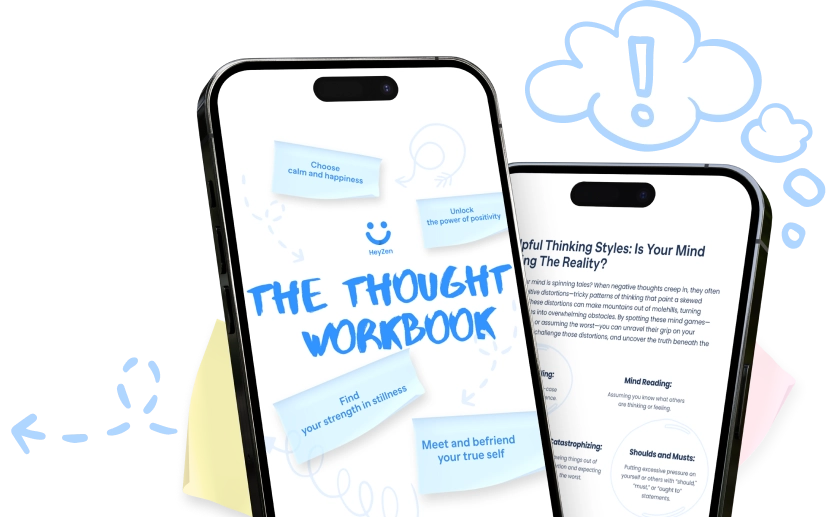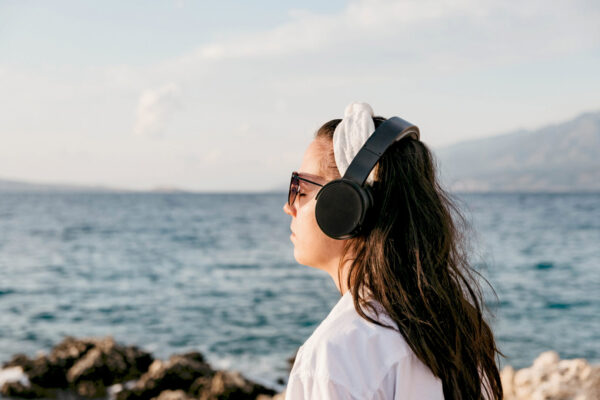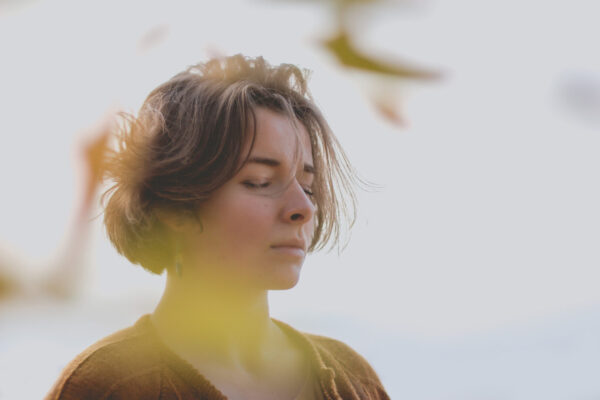15 Best Yoga Apps in 2025: The Newest Practice Guide

In 2025, yoga apps have revolutionized how we experience this ancient practice, making it more accessible than ever to maintain a consistent yoga routine from anywhere, at any time. So, nothing holds you back from reaping all the mental & physical health benefits yoga is ready to provide you with! Whether you’re a beginner looking to start your yoga journey or an advanced practitioner seeking to deepen your practice with the best chair yoga apps or the best somatic yoga apps, you will definitely find your perfect app in our HeyZen list!
Key takeaways
- Down Dog leads as the best overall yoga app in 2025, offering AI-powered personalized sequences and HD video demonstrations with 3D modeling for precise form correction.
- Find What Feels Good (FWFG) stands out as the top beginner-friendly app, featuring 200+ structured classes and detailed pose breakdowns for newcomers.
- Advanced practitioners benefit from apps offering 4,000+ expert-led classes, customizable sequences, and specialized workshops for mastering complex poses.
- Glo excels in personalization, providing AI-driven custom programs based on individual goals, with access to over 4,000 classes across yoga, Pilates, and fitness training.
- Modern yoga apps integrate cutting-edge technology like AI pose detection, VR/AR features, and wearable device synchronization for enhanced practice experiences.
- While traditional yoga classes may benefit beginners and those who prefer physical guidance from a yoga teacher, digital apps can help practice yoga flexibly but with the guidance of a video recording.
The evolution of digital yoga practice
With the surge of yoga apps, practitioners now have unprecedented access to varied styles, levels, and instructors right at their fingertips. The digital medium has not only democratized yoga, making it accessible to all walks of life, but it has also allowed practitioners to customize their experience according to their personal goals and preferences. In 2025, the landscape has evolved further, with apps integrating advanced features like AI personalization, augmented reality, and comprehensive health tracking, all designed to enhance the practitioner’s journey.
These apps offer a lot of features that cater to beginners and seasoned yogis alike. For example, comprehensive onboarding processes now help users identify their specific needs—whether they are looking for stress relief, improved flexibility, or strength building. Also, most platforms come equipped with a vast library of classes covering various yoga disciplines, such as Hatha, Vinyasa, and Ashtanga, allowing users to explore new styles without the constraints of a physical studio. Coupled with clear, professional instruction and visual demonstrations, these apps have the power to create immersive at-home experiences that make yoga practice not only effective but also engaging.
Moreover, the community-building aspects of these apps have also flourished. Features like live-stream classes, instructor Q&As, and community forums provide users with a sense of connection, which is particularly vital in times when physical studios may be far less accessible. Some apps even offer challenges or social sharing options, encouraging users to stay motivated and committed to their practice. As we look forward into 2025, the yoga app realm will likely continue to adapt, potentially incorporating even more interactive and gamified elements that can make wellness journeys both fulfilling and enjoyable for users of all levels.
Benefits of digital yoga apps
Digital yoga apps transform traditional practice through five core advantages:
Personalized experience
- AI-powered pose analysis adapts sequences to your flexibility level.
- Custom practice duration options range from 5 to 90 minutes.
- Progress tracking with detailed metrics on strength, flexibility, and balance.
Convenience & accessibility
- Practice anywhere with minimal equipment requirements.
- Access 1000+ classes across different yoga styles.
- Download sessions for offline viewing during travel.
Cost-effectiveness
| Traditional Studio | Digital Yoga App |
| $120/month avg | $15/month avg |
| Limited classes | Unlimited access |
| Fixed schedules | 24/7 availability |
Expert guidance
- HD video demonstrations from certified instructors.
- Real-time form corrections through motion tracking.
- Voice-guided cues for proper alignment technique.
Community integration
- Virtual group sessions with live participant interaction.
- Achievement sharing on social platforms.
- Community challenges with global leaderboards.
- Direct messaging with certified yoga instructors.
These integrated features create comprehensive digital yoga experiences that enhance practice consistency and motivation. The apps’ ability to combine structured guidance with flexibility makes yoga accessible to practitioners at every skill level.
The best app for all levels
HeyZen emerges as the leading yoga app in 2025, combining artificial intelligence with personalized practice sessions and scientific insights. This app stands out for its ability to generate entirely fresh sequences for each session, preventing repetitive routines. It can be personalized to any level of yoga and various mental health goals, i.e., anxiety, ADHD, childhood trauma, etc.
Key features
- Classes range from hatha yoga, de-stress classes, and mind-body connection exercises to nidra yoga, meditation sessions, and educational podcasts—all created by registered yoga instructors and neuroscientists.
- Positive affirmations and quotes inside the app.
- Dynamic sequence generation creates unique flows for every practice.
- Voice-assisted guidance in 10 languages, including Spanish, French, and German.
- HD video demonstrations for precise form correction.
- Customizable practice duration from 5 to 90 minutes.
- It’s available both on the Apple App Store and Google Play.
Pros and cons
| Pros | Cons |
| Unlimited unique yoga sequences | A limited number of free days |
| Offline mode available | Premium features cost extra |
| A free trial period available | Requires a stable internet connection |
| Multiple difficulty levels | Limited community features |
| Meditations and podcasts | No live classes |
| Regular app updates | Higher storage requirement |
The best app for beginners
Find What Feels Good (FWFG) leads the beginner-friendly yoga app category in 2025 with its approachable interface. The app combines gentle guidance with structured progression paths to help newcomers build confidence in their practice.
Key features
- Step-by-step video tutorials with detailed pose breakdowns.
- 200+ beginner-specific classes organized by difficulty level.
- Customizable practice durations from 5 to 60 minutes.
- Progress tracking with achievement milestones.
- Offline access to downloaded classes.
- Voice-guided instructions with optional subtitles.
Pros and cons
| Pros | Cons |
| Clear beginner-focused instruction | Limited advanced content |
| Comprehensive pose library | Requires stable internet for streaming |
| Integration with Apple Health | Some features need premium access |
| Multi-device sync | Monthly download limits on the basic plan |
| HD video quality | No live classes |
Pricing
| Plan Type | Cost | Features |
| Basic | Free | 30+ beginner classes |
| Monthly | $9.99 | Full library access |
| Annual | $89.99 | All features + offline downloads |
| Lifetime | $299.99 | Permanent access to all content |
Each plan includes access to the beginner foundations program plus complimentary meditation sessions. The annual subscription offers a 25% savings compared to monthly billing.
The best app for advanced practitioners
Down Dog is a favorite yoga app of advanced practitioners. It offers sophisticated features for deepening your practice. These apps integrate advanced pose tutorials, customizable sequences, and expert-led workshops to enhance the advanced mindfulness journey.
Key features
- 4,000+ expert-led classes with advanced pose variations.
- Customizable practice filters by duration (15-120 minutes), style (Ashtanga, Kundalini, Power), and focus areas.
- Advanced pose tutorials with detailed alignment instructions.
- Progressive workshop series for mastering complex poses.
- Integration with fitness tracking devices for performance monitoring.
Pros and cons
Pros:
- Extensive library of advanced-level content.
- Multiple customization options for practice intensity.
- Professional instruction from certified teachers.
- Goal-based programs for skill progression.
- Community features for connecting with fellow practitioners.
Cons:
- Premium features require paid subscriptions.
- A stable internet connection is needed for streaming.
- Limited offline access options.
- Higher price point compared to basic apps.
Pricing
| Plan | Cost | Features |
| Basic | Free | Limited sequences of daily workouts |
| Monthly | $9.99 | Full access unlimited sequences |
| Annual | $59.99 | All features plus offline downloads |
| Lifetime | $199.99 | One-time payment for permanent access |
The best app for personalized programs
Glo emerges as the leading personalized yoga app in 2025, offering tailored programs that adapt to individual fitness goals. The app combines artificial intelligence with expert instruction to create customized yoga experiences for practitioners at every level.
Key features
- Over 4,000 classes spanning yoga, Pilates & fitness training.
- Customizable programs based on specific goals like flexibility, pose mastery & stress reduction.
- Live & pre-recorded sessions with experienced yogis.
- Educational courses & guided meditations.
- Class filtering by style, level, duration & time of day.
- Multi-platform access across devices.
- Offline downloading capabilities.
Pros and cons
Pros:
- Extensive library of personalized content.
- Expert-led instruction from certified teachers.
- Diverse class styles & duration options.
- Regular content updates.
- High-quality video production.
Cons:
- Premium features require a subscription.
- Limited community interaction features.
- Some advanced poses need in-person guidance.
- Bandwidth-intensive streaming quality.
Pricing
| Plan Type | Price | Features |
| Monthly | $24.99 | Full access to all content |
| Annual | $199.99 | $16.67/month, 33% savings |
| Student | $16.99 | Valid student ID required |
| Group | $18.99/user | Minimum 5 users |
| Free Trial | 7 days | Access to all premium features |
The best app for meditation and mindfulness
Alo Moves leads the meditation and mindfulness category in 2025 by combining traditional practices with comprehensive mental wellness features. The app excels in creating a holistic mind-body experience through its integrated approach to movement and meditation.
Key features
- High-definition video classes filmed in serene environments.
- Weekly content updates with fresh meditation sessions.
- Combined yogic movements and mindfulness exercises.
- Integrated breathwork techniques for stress reduction.
- Multi-platform accessibility across devices.
- Downloadable content for offline practice.
Pros and cons
| Pros | Cons |
| Extended 14-day trial period for full feature testing | Premium subscription required for access |
| Professional-grade video production quality | No permanent free version available |
| Multiple difficulty levels | Limited offline functionality |
| Regular content updates with new classes | Download required for offline viewing |
| Seamless integration of physical and mental practices | Basic search functionality |
Pricing
| Subscription Type | Cost |
| Monthly Plan | $20/month |
| Annual Plan | $199/year |
| Free Trial Period | 14 days |
Note: The pricing table reflects current rates as of 2025 and includes unlimited access to all meditation and mindfulness content.
3 specialized yoga apps
Specialized apps cater to specific practice styles and demographics, offering targeted content and features for unique needs. These apps provide expert-led sessions with customized approaches for different yogic disciplines.
The best for prenatal yoga
PregActive offers trimester-specific yoga sequences with modified poses for pregnancy. The app includes specialized prenatal exercise plans integrated with nutritional guidance and wellness coaching features. YouAligned provides targeted sessions focusing on both physical adaptations and mental preparation throughout pregnancy stages.
The best for Yoga Nidra
IAM Yoga Nidra leads the meditation-focused category with comprehensive Yoga Nidra sessions. The app incorporates guided relaxation techniques and mental wellness practices designed for deep restorative sleep and stress reduction.
The best for kids and families
Cosmic Kids Yoga provides interactive elements that engage children through gamified yoga sequences and storytelling. The app includes family-friendly group sessions with modifications for different age groups and ability levels.
Yoga apps vs. other fitness apps
Yoga apps offer specialized features for mind-body wellness, while fitness apps focus on physical exercise metrics. The distinctions between these app categories determine their effectiveness for specific health objectives.
Comparing features and benefits
Yoga apps prioritize form alignment correction through HD video demonstrations with detailed pose breakdowns. These apps include:
- Guided breathing exercises integrated with movement sequences.
- Meditation sessions ranging from 5-60 minutes.
- Over 4,000 expert-led classes across multiple yoga styles.
- Customizable practice durations from 10-90 minutes.
- Progress tracking for flexibility improvements.
| Feature Type | Yoga Apps | Fitness Apps |
| Class Types | 2,500+ yoga flows | 1,000+ workouts |
| Session Length | 10-90 minutes | 5-60 minutes |
| Focus Areas | Flexibility, balance, mindfulness | Strength, cardio, muscle gain |
| Tracking Metrics | Pose alignment, breath work | Calories, reps, heart rate |
Integrating yoga into your overall fitness routine
Combining yoga apps with fitness applications creates a balanced exercise program. Key integration points include:
- Practice yoga on rest days between high-intensity workouts.
- Incorporate 10-minute yoga flows as warm-ups before strength training.
- Use meditation sessions for post-workout recovery.
- Schedule two yoga sessions per week for flexibility maintenance.
- Track both physical metrics and mindfulness progress across platforms.
- Morning yoga + evening strength training.
- HIIT workouts + restorative yoga.
- Running + flexibility-focused yoga flows.
- Weight training + balance-building poses.
- Cardio sessions + cooling yoga sequences.
Traditional yoga classes vs. online yoga apps
The debate between traditional classes and online apps is one that many practitioners find themselves navigating. Each option has its own advantages and drawbacks, making the best choice highly subjective and dependent on individual preferences and lifestyle.
Traditional classes have long been the gold standard for most yogis, offering an environment that fosters communal spirit and personal interaction. In a studio setting, students benefit from immediate feedback from certified instructors, which can enhance alignment, technique, and overall practice. The physical presence of a teacher helps create accountability, encouraging attendees to show up consistently. Moreover, the energy of a shared space can boost motivation and lift moods, creating an inspiring environment conducive to mindfulness and relaxation.
On the other hand, the surge in online apps has revolutionized the way we approach our practice. These platforms offer the convenience of practicing at home or anywhere with an internet connection, breaking geographical barriers that previously limited access to quality instruction. Many apps boast a wealth of features—from libraries of on-demand videos covering various styles of yogic practices (like vinyasa, hatha, or yin) to customized plans tailored to individual goals, whether they be strength-building, flexibility improvement, or stress relief. Also, online apps often come with a more affordable price point, offering flexible subscription options that allow users to pay for only the features they desire.
Notably, online apps have also adapted to cater to the diverse needs of modern practitioners. Many are now incorporating features like interactive live classes, community forums, and personalized metrics to track progress over time. This commitment to evolving with the user experience not only keeps the practice engaging but also fosters a sense of belonging within a virtual community. However, novices or those still exploring their yoga journey may find the personal touch of in-person classes particularly beneficial for building comfort and understanding of poses.
Technology in yoga apps
Modern apps use advanced technologies to create immersive and personalized practice experiences. These technological innovations transform how practitioners engage with yoga in the digital age.
AI-powered personalization
Artificial intelligence enhances yogic practices through smart pose detection and real-time feedback. The Google Gemini 1.5 Pro model powers apps like Eva Yoga to analyze movement patterns and provide instant corrections. AI algorithms create custom sequences based on:
- Practice history and progression
- Individual flexibility levels
- Specific fitness goals
- Time constraints
- Physical limitations
Virtual reality and augmented reality in yoga
VR and AR technologies create immersive yoga environments with 3D visualization features:
- 360-degree pose viewing angles
- Interactive pose alignment guides
- Virtual studio environments
- Real-time form corrections
- Digital instructor demonstrations
Wearable integration
Yoga apps sync with fitness trackers and smartwatches to monitor vital metrics during practice:
| Metric | Tracking Purpose |
| Heart Rate | Intensity monitoring |
| Breathing Pattern | Pranayama efficiency |
| Movement Analysis | Pose alignment |
| Calories Burned | Energy expenditure |
| Practice Duration | Session tracking |
User guide: getting the most out of your yoga app
Yoga apps transform any space into a personal studio through proper setup customization. Here’s how to optimize your digital yoga experience for maximum benefit.
Setting up your practice space
A dedicated space enhances the digital practice experience through proper organization. Create a clutter-free area of 6×8 feet minimum with these elements:
- Place your device at eye level, 3-4 feet away, for clear video viewing.
- Position a non-slip mat on a flat, stable surface.
- Ensure proper lighting with 2-3 light sources to minimize glare.
- Set room temperature between 68-72°F for comfort.
- Keep props (blocks, straps, blankets) within arm’s reach.
Creating a consistent routine
Regular practice establishes lasting habits through structured scheduling. Optimize your sessions with these strategies:
- Schedule 3-5 weekly sessions at fixed times.
- Download classes for offline access before practice.
- Enable notification reminders 15 minutes before start time.
- Track progress through the app’s built-in analytics.
- Save favorite classes to a custom playlist for quick access.
Troubleshooting common issues
- Clear app cache monthly to prevent loading delays.
- Update the app weekly for optimal performance.
- Check internet speed (minimum 5 Mbps) for smooth streaming.
- Restart the device if video playback stutters.
- Contact app support for login or subscription issues.
- Toggle airplane mode on/off to resolve sync problems.
| Issue Type | Solution Steps | Expected Resolution Time |
| Video Buffering | Check WiFi Reset Router | 5 minutes |
| Audio Sync | Clear Cache Restart App | 2 minutes |
| Loading Errors | Update App Force Close | 3 minutes |
The future of yoga apps
Apps continue to evolve with technological advancements, creating more immersive and personalized experiences. The integration of artificial intelligence, virtual reality, and biometric tracking transforms how practitioners engage with digital platforms.
Emerging trends in yoga styles
- AI-Powered Personalization: Advanced algorithms analyze movement patterns through device cameras to provide real-time pose corrections and personalized adjustments.
- Virtual Reality Integration: Immersive 3D environments enable 360-degree pose viewing with interactive alignment guides from multiple angles.
- Biometric Integration: Syncing with wearables tracks vital metrics, including heart rate variability, breathing patterns, and range of motion during practice.
- Social Connection Features: Built-in communities facilitate group practices, pose challenges, and progress sharing among practitioners.
- Voice-Activated Controls: Hands-free navigation through voice commands enables seamless transitions between poses and sequences.
Predictions for the next five years
- Advanced Motion Tracking: Implementation of 3D body mapping technology for precise form analysis and injury prevention.
- Customized Audio Experiences: Spatial audio integration creates immersive soundscapes that adapt to practice intensity and style.
- Enhanced Accessibility Features: Development of specialized content for practitioners with limited mobility or specific health conditions.
- Cross-Platform Integration: Seamless synchronization across devices enables consistent practice tracking and progress monitoring.
- Augmented Reality Overlays: Real-time visual guides project proper alignment cues onto practitioners’ bodies through smartphone cameras.
Free vs. paid yoga apps
Apps in 2025 offer both free and premium options to accommodate different budgets and practice needs. The choice between free and paid versions depends on specific requirements for practice depth, customization features, and content variety.
Top free yoga apps
Free apps provide essential features for a basic practice:
- 5-Minute Yoga offers quick sessions with basic pose instructions suitable for busy schedules.
- Simply Yoga includes fundamental poses focusing on balance, strength, and flexibility.
- Daily Yoga provides access to beginner programs with basic customization options.
- Down Dog features customizable sequences with options to select style, level, and duration.
| Free App Feature | Availability |
| Basic Poses | 100% |
| Beginner Programs | 75% |
| Offline Access | 25% |
| Custom Sequences | 50% |
Is the premium worth it?
- Access to 4,000+ expert-led classes across multiple styles and levels.
- Offline downloads for practicing without an internet connection.
- Personalized programs tailored to specific goals and progress.
- HD video quality with detailed pose instructions modifications.
- Live classes, community features, and instructor feedback.
| Premium Feature | Monthly Cost Range |
| Basic Premium | $10-15 |
| Standard Premium | $16-24 |
| Elite Premium | $25-30 |
| Annual Discount | 25-40% |
Conclusion
The rapid evolution of technology has profoundly transformed the way we engage with yoga, making it more accessible and adaptable to individual needs. As we navigate through the options available in 2025, it’s important to consider not just the variety of classes or instructors but also the unique features that enhance your practice. From personalized programs that adapt to your progress to community features that foster a sense of belonging, the best apps of this year cater to a range of experiences, making yoga an inclusive practice for everyone.
Many of the top apps incorporate elements such as meditation, breathing exercises, and wellness tracking, allowing users to create a comprehensive routine that nurtures both body and mind. This holistic approach is critical, especially in today’s fast-paced world, where mental health and spiritual well-being are as important as physical fitness. By choosing an app that aligns with your personal goals—be it improving flexibility, reducing stress, or enhancing mindfulness—you can tailor your practice to meet your personal needs.
As you embark on your journey to find the perfect yoga app, keep in mind the user experience, accessibility, and the quality of content offered. A well-designed app should provide intuitive navigation, high-resolution videos, and the ability to track your progress over time. Also, reading user reviews and checking out free trials can give you valuable insights into whether an app fits your lifestyle and preferences. Remember, the goal is to cultivate a practice that resonates with you, one that you will sustain for the long run!
FAQ
How many classes should I have daily?
It depends on your individual goals, fitness level, and lifestyle. For beginners, one class daily can be a great way to gain health benefits from yogic practices and also focus on essential postures, alignment, and breathing techniques. This daily commitment not only cultivates a sense of routine but also helps to build muscle memory and improve flexibility over time. Many yoga instructors recommend starting with one class a day, especially for those new to the practice, to avoid burnout and cultivate a sustained interest in the practice. For more advanced practitioners, the frequency of classes can be more flexible. Some individuals may choose to attend multiple classes each day, practicing different styles simultaneously.
What are the best yoga apps in 2025?
Down Dog, HeyZen, Find What Feels Good (FWFG), Glo, and Alo Moves are among the top-rated yoga apps in 2025. Each app offers unique features catering to different needs and skill levels, from beginners to advanced practitioners.
How much do premium yoga apps cost in 2025?
Most premium apps range from $15 to $30 per month. Annual subscriptions offer savings of 20-25%. For example, Down Dog costs $22.99 monthly, while Glo is priced at $24.99 monthly. Many apps offer free trials and student discounts.
Are there free yoga apps available?
Yes, several apps offer free basic features. Apps like Down Dog, 5-Minute Yoga, and Simply Yoga provide essential poses and beginner programs at no cost. However, advanced features and premium content require paid subscriptions.
What features do AI-powered yoga apps offer?
AI-powered apps like Down Dog and Eva Yoga provide personalized sequences, real-time pose corrections, and adaptive programs based on your progress. They use smart pose detection and analyze movement patterns to offer customized feedback.
Can I practice yoga offline using these apps?
Most premium apps offer offline downloading capabilities. This feature allows you to download classes and practice without an internet connection. However, some features like live classes and real-time feedback require internet connectivity.
Which app is best for beginners?
Find What Feels Good (FWFG) is the top-rated beginner-friendly app in 2025. It offers over 200 beginner-specific classes, step-by-step tutorials, and structured progression paths to help newcomers build confidence.
Do yoga apps integrate with fitness trackers?
Yes, most modern apps sync with fitness trackers and wearables to monitor vital metrics like heart rate, breathing patterns, and movement analysis. This integration helps track progress and optimize practice routines.
Are there specialized yoga apps for specific needs?
Yes, there are apps designed for specific practices like prenatal yoga (PregActive), hot yoga, restorative yoga, and family yoga. These apps offer targeted content and features tailored to unique requirements.
